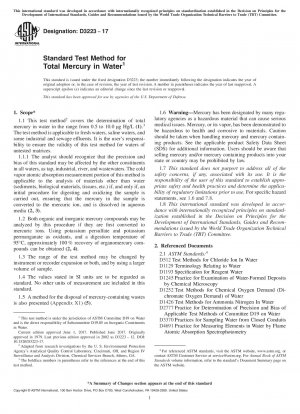ASTM D3223-17
Standard Test Method for Total Mercury in Water
- Standard No.
- ASTM D3223-17
- Release Date
- 2017
- Published By
- American Society for Testing and Materials (ASTM)
- Latest
- ASTM D3223-17
- Scope
- 1.1 This test method2 covers the determination of total mercury in water in the range from 0.5 to 10.0 µg Hg/L (1).3 The test method is applicable to fresh waters, saline waters, and some industrial and sewage effluents. It is the user’s responsibility to ensure the validity of this test method for waters of untested matrices. 1.1.1 The analyst should recognize that the precision and bias of this standard may be affected by the other constituents in all waters, as tap, industrial, river, and wastewaters. The cold vapor atomic absorption measurement portion of this method is applicable to the analysis of materials other than water (sediments, biological materials, tissues, etc.) if, and only if, an initial procedure for digesting and oxidizing the sample is carried out, ensuring that the mercury in the sample is converted to the mercuric ion, and is dissolved in aqueous media (2, 3). 1.2 Both organic and inorganic mercury compounds may be analyzed by this procedure if they are first converted to mercuric ions. Using potassium persulfate and potassium permanganate as oxidants, and a digestion temperature of 95°C, approximately 100 % recovery of organomercury compounds can be obtained (2, 4). 1.3 The range of the test method may be changed by instrument or recorder expansion or both, and by using a larger volume of sample. 1.4 The values stated in SI units are to be regarded as standard. No other units of measurement are included in this standard. 1.5 A method for the disposal of mercury-containing wastes is also presented (Appendix X1) (5). 1.6 Warning—Mercury has been designated by many regulatory agencies as a hazardous material that can cause serious medical issues. Mercury, or its vapor, has been demonstrated to be hazardous to health and corrosive to materials. Caution should be taken when handling mercury and mercury containing products. See the applicable product Safety Data Sheet (SDS) for additional information. Users should be aware that selling mercury and/or mercury containing products into your state or country may be prohibited by law. 1.7 This standard does not purport to address all of the safety concerns, if any, associated with its use. It is the responsibility of the user of this standard to establish appropriate safety and health practices and determine the applicability of regulatory limitations prior to use. For specific hazard statements, see 1.6 and 7.8. 1.8 This international standard was developed in accordance with internationally recognized principles on standardization established in the Decision on Principles for the Development of International Standards, Guides and Recommendations issued by the World Trade Organization Technical Barriers to Trade (TBT) Committee.
ASTM D3223-17 Referenced Document
- ASTM D1129 Standard Terminology Relating to Water
- ASTM D1193 Standard Specification for Reagent Water
- ASTM D1245 Standard Practice for Examination of Water-Formed Deposits by Chemical Microscopy
- ASTM D1252 Standard Test Methods for Chemical Oxygen Demand (Dichromate Oxygen Demand) of Water
- ASTM D1426 Standard Test Methods for Ammonia Nitrogen In Water
- ASTM D2777 Standard Practice for Determination of Precision and Bias of Applicable Methods of Committee D-19 on Water
- ASTM D3370 Standard Practices for Sampling Water from Closed Conduits
- ASTM D4691 Standard Practice for Measuring Elements in Water by Flame Atomic Absorption Spectrophotometry
- ASTM D4841 Standard Practice for Estimation of Holding Time for Water Samples Containing Organic and Inorganic Constituents*, 2018-10-15 Update
- ASTM D512 Standard Test Methods for Chloride Ion In Water
- ASTM D5810 Standard Guide for Spiking into Aqueous Samples *, 2021-07-01 Update
- ASTM D5847 Standard Practice for Writing Quality Control Specifications for Standard Test Methods for Water Analysis
ASTM D3223-17 history
- 2017 ASTM D3223-17 Standard Test Method for Total Mercury in Water
- 2012 ASTM D3223-12 Standard Test Method for Total Mercury in Water
- 2002 ASTM D3223-02(2007)e1 Standard Test Method for Total Mercury in Water
- 2002 ASTM D3223-02 Standard Test Method for Total Mercury in Water
- 1995 ASTM D3223-95 Standard Test Method for Total Mercury in Water
- 1991 ASTM D3223-91 Standard Test Method for Total Mercury in Water
